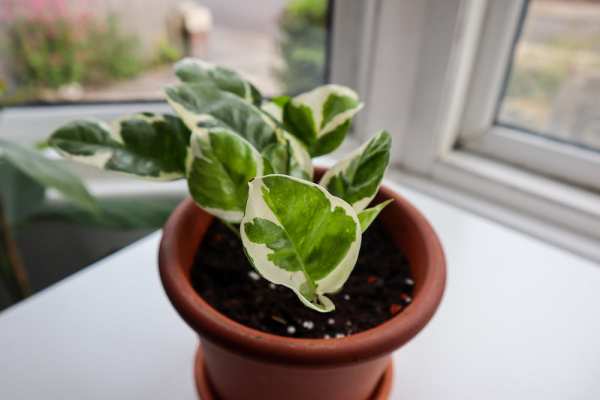Pothos plant is a popular house famous for low maintenance and beautiful stems. Pothos plant is known by many other names such as devil’s ivy, golden pothos, or money plant. Golden ivy does well in little water and low or indirect light.
The pothos plant makes a beautiful edition in every home, room, or office. It has light green leaves growing on similar colored soft stems with veiny tips. Pothos tend to rise and fall out of the vase/pot it is grown in and thus can also be used in hanging pots.
A houseplant, the pothos plant is known for its distinctive looks and easy to take care of attitude. The pothos plant needs little to average indirect light and some water. While they thrive in nutrient-rich soil, they don’t necessarily die in soil that isn’t very high in nutrients.
Moreover, pothos plants can be grown in a vase of water or even a pot of soil nourished with fertilizer and prepped with water. Fun fact- pothos plants do not need sunlight to grow.
What is Drainage in Plants?
Each pot (at least a good one) has drainage holes at the bottom. Drainage holes are tiny holes made in the base of a pot, allowing excess water to drip down from the soil. Most people place a tray under the holes to collect excess water and discard it timely to prevent water-logging.
Drainage holes ensure that excess water from the soil does not stay put and goes out of the plant, thus preventing overwatering, which can cause rotting.
Do Pothos Need Drainage?

Yes! Pothos plants are native to SouthEast Asia and Pacific regions, which are tropical; they are more tolerant of under watering than overwatering. As mentioned above, drainage ensures that excess water finds a way out of the soil and prevents waterlogging.
Pothos plants do not require a lot of water, and thus, it becomes imperative to allow them to drain. Here are the steps to follow to allow drainage-
Choose a pot with drainage holes and place a tray under it to collect water.
Also Read: Why Are My Fern Leaves Turning Brown?
Water the plant
- Allow the top 1-2 inches of soil to dry before watering
- Before watering again, discard the water contained in the tray
Benefits of a Pothos Plant
Most people care for a pothos plant for beauty and aesthetic pleasure; however, there are many benefits that it provides, most unknown to many.
Easy to maintain
For a plant lover/cultivator, the significance of a plant being low maintenance is very high. If you have a busy schedule and yet want to be a plant parent, pothos plant could be a good option for you.
Money plants can grow with very little water, so it is all good even if you forget to water the plant a few times. Moreover, pothos is a houseplant in the truest sense of the word as it does not require any sunlight to bloom and grow. Place it anywhere with artificial light and water it every once in a while.
Also Read: Why is My Croton Dropping Leaves?
Purifies the air
The pothos plant cleans the air of toxins such as benzene, formaldehyde, xylene, carbon monoxide, and other harmful toxins. These toxins have dangerous and often fatal effects on our health.
Pothos plant acts as a natural air purifier and cleans the surrounding air by absorbing toxins. It also absorbs excess carbon dioxide and ozone from the surroundings.
Increases humidity
Pothos plant also aids in excellent and restful sleep by increasing the humidity in the air. Higher humidity and lower levels of dryness aid in better breathing and thus make it easier to fall or stay asleep.
Also Read: How to Get Rid of Bugs on Jade Plants?
Versatile
Pothos plants are versatile and can be grown in many pots or containers, and even vases. They can be grown in containers kept on windowsills, shelves, mantles, or even containers hung from hooks on the wall.
Pothos plants grow out of their pots and look like vines; they look stunning when hung in pots overhead.
Feng shui, Vastu, money plant
In countries like India, money plants are named such as it is believed to bring wealth for the owners. Pothos plants are also considered to be suitable for Vastu (astrological predictions) and fengshui.
Caring for a pothos plant
Pothos plant does not need too much attention and effort from your side to bloom. With some light and little water, a pothos plant will flourish. Here’s how to take care of a pothos plant.
Light
Pothos plant does not require too much light. It can be grown indoors or outdoors, in closets, offices, and bedrooms. A tip for beginners is to keep the pothos plant in an area with indirect light, as that would be the most suitable.
Pothos plant does well in numerous light conditions except for direct sunlight under which it withers. You can also decide light conditions based on the variegation of the plant. As only the green parts of a leaf can photosynthesize, choose light conditions depending on it.
If variegation is less, choose more light and vice versa.
Water
Pothos plant requires an average amount of water. You can water your plant once or twice a week depending on the weather at that time and the dampness of the soil.
Since pothos plants can thrive even in little water, you can adequately take care of them even if you are someone with a packed schedule. Say you forgot to water the pothos on the designated day; the plant would be fine for a few more days without water.
Allow the top layer of the soil to dry before watering the plant again, do no overwater as it can cause rot. Place a saucer below the drainage holes and empty it before the next watering to prevent waterlogging.
Also Read: How Often Should I Water My Peace Lily?
Fertilizer
Fertilizers keep the soil rich in nutrients that are required for a plant to grow and flourish. Pothos plants do not need too much fertilization; they fertilize every three months with a natural and balanced fertilizer for the best results.
Cleaning
Gently wipe the leaves of the pothos plant with a damp cloth to keep away dust and insects like mites which can eat away your plants’ leaves. Do not use industrial cleaners as they can clog the leaves. Do not neglect cleaning your plant.
Pruning
Pothos plants tend to sprawl and grow out of the pot. It is this very sprawling look that gives it the appearance of being a vine. As for pruning, allow the plant to grow naturally but cut bare and long-running stems to allow a bushy growth.
Pot requirements
Pothos plants can grow in many types of pots- from window-sized to hanging and even vases. Choose a pot that is 2 inches bigger than the root ball and with adequate drainage holes.
Voila! You have successfully allowed drainage in the pothos plant.
